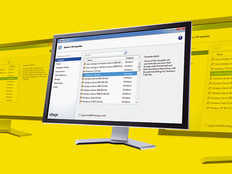How the University of Colorado Saved 12,000 Trees and Cut Costs by 55 Percent with Green Technology
The University of Colorado Boulder is a leader in sustainability. One of the key areas for any sustainability program is technology. Devices and services consume huge amounts of electricity and need to be refreshed every two to four years. It’s a drain on budgets and the environment.
Robert Dixon, IT director for housing and dining at the university, is responsible for the largest computerized department at the university and has taken the initiative to cut down on waste and educate students and faculty on how their use of computers and printers affects the school’s mission. His department operates as an auxiliary and functions like a small business within the university.
EdTech recently interviewed Dixon about green IT and several of his projects.
EDTECH: IT is complicated without sustainability. How does the university's mission to go green affect technology?
DIXON: Well, our first priority is to solve the business and administrative needs of the department, which is a challenge in itself. We have about 25 different critical business systems pulling from about 150 databases, so being green is difficult. Some hardware is better for sustainability than other hardware — LEDs are better than LCDs, for example — but there are a lot of limitations when you have as many desktop computers as we do. A zero client uses about 11 watts, which is about the same as a bathroom nightlight. Sustainability was one of the reasons we moved to a virtual desktop environment, but there is also an increase in the consistency of computing and a reduction in cost. It also gives people mobility, which is necessary in housing.
We virtualized our servers as well to become more sustainable. I don't know if you could be as green as we are without virtualizing the desktop.
EDTECH: How does virtualization prepare the University of Colorado Boulder for the future?
DIXON: Instead of purchasing new computers, we are buying monitors and a zero client that is basically a circuit board in a box. You really don't need to replace them, since they are solid state and there are no moving parts. All of the computing is happening on the back end, so the devices are just delivering computing power from the powerful servers in our data center.
I hope to get many years of life from these end points instead of refreshing all the hardware every two to four years, like we had done in the past. With the budget we save, we can get our employees laptops or tablets that are also virtualized. And those don't need to be high end, since they are just delivering virtualized computing power also. You save now and you save in the future.
EDTECH: How many devices have you virtualized?
DIXON: We have 400 virtual desktops and still have about 20 full-client workstations, which we are in the process of converting. We also have about 100 laptops, 50 tablets and 300 phones.
EDTECH: What other sustainability projects have you taken on?
DIXON: Years ago, we had computer labs in the dorms, all with free printing. That got to be a problem because students and faculty were printing a lot, and it was costing us a lot of money. We also run the campus ID card program, Buff OneCard, and we married that technology with printer software and our Xerox printers. We set it up so that you had to swipe your card in order to retrieve your printed documents. It gave us a more precise measurement of who was printing what, and prevented people from printing documents and never retrieving them. We allowed students to print a certain amount for free and then charged a small fee after that. It reduced our printing costs by 55 percent in the first year. That caught on with the rest of campus and rolled out a similar model across campus. That program has been in place for about 10 years now and saves about 7.5 million prints per year. Over 10 years, we've saved more than 12,000 trees.
In our department, we have about 100 printers, and it costs us about $100,000 each year. We use a printer auditing software to measure the amount of paper and ink used, and we integrated that with our time and attendance software to track specific information about printing in each organizational department of housing. Each person can see data about their printing — color versus black and white, single page versus duplex — and managers in each department can measure their use as well. I don't know of any other colleges that have done this. Now that we have a measurement, we are working on ways to motivate the staff to reduce printing. You can't manage what you can't measure.
EDTECH: Is there a piece of advice on sustainability you would offer to other IT departments?
DIXON: If you want to virtualize your desktop environment, look at your hardware refresh cycle, and plan to use some of the budget for thin clients and computing power. There is an up-front cost, but the cost savings are significant. I would, however, recommend doing a pilot first. For us, the trifecta of hardware was Cisco UCS blade servers, Nimble's storage drives and VMware Fusion 5. It's been a winning solution for us.
To learn more about Dixon’s efforts, watch his presentation at EDUCAUSE, and read this case study from Nimble Storage.








